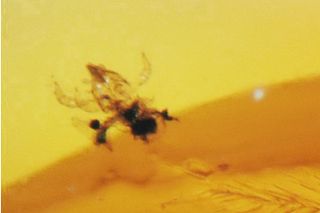How Do Aquatic Creatures Get Fossilized in Tree Sap?

They probably never saw it coming. Minding their business, swimming around and then suddenly, their lives end in sticky resin from high up in a tree.
Bodies of freshwater creatures found frozen in amber have always puzzled scientists. Previously, scientists assumed the yellow-colored fossil of amber formed only on land. But researchers at the Museum of Natural History in Berlin recently discovered just how trees’ ancient, slow-moving sticky stuff might have caught swimming creatures and then turned to amber.
The scientists’ research suggests that resin dripped down the trunks of pine-like trees and fell into a swamp below. As the goo flowed into the water, it swallowed innocent swimmers-by, such as beetles and small crustaceans. The resin settled to the bottom and was covered by sediment.
After millions of years, the swamp dried up and the animal-rich resin hardened into amber.
Follow Life's Little Mysteries on Twitter @llmysteries. We're also on Facebook & Google+.
Sign up for the Live Science daily newsletter now
Get the world’s most fascinating discoveries delivered straight to your inbox.

